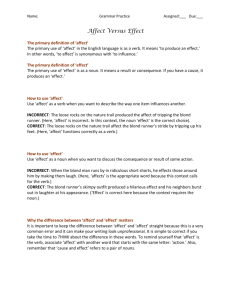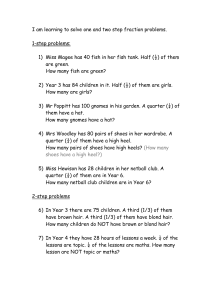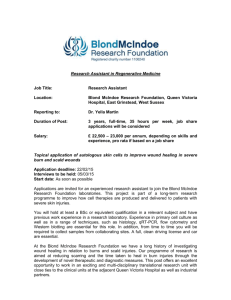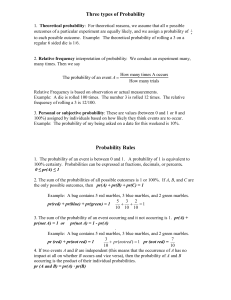Black
advertisement
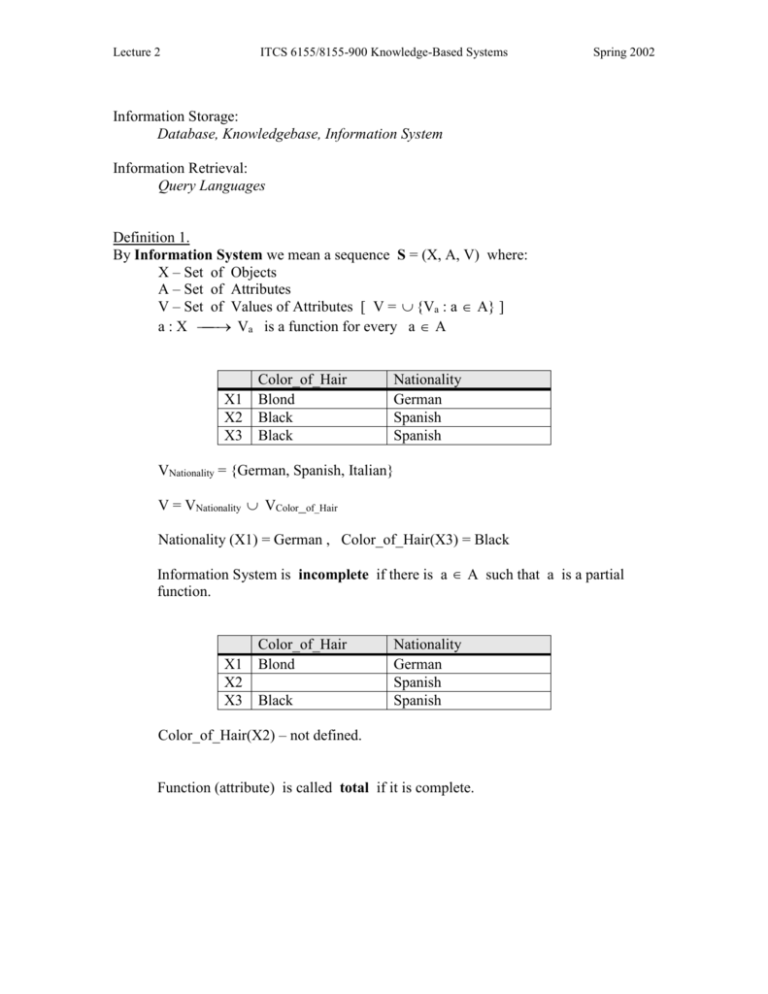
Lecture 2
ITCS 6155/8155-900 Knowledge-Based Systems
Spring 2002
Information Storage:
Database, Knowledgebase, Information System
Information Retrieval:
Query Languages
Definition 1.
By Information System we mean a sequence S = (X, A, V) where:
X – Set of Objects
A – Set of Attributes
V – Set of Values of Attributes [ V = {Va : a A} ]
Va is a function for every a A
a:X
X1
X2
X3
Color_of_Hair
Blond
Black
Black
Nationality
German
Spanish
Spanish
VNationality = {German, Spanish, Italian}
V = VNationality VColor_of_Hair
Nationality (X1) = German , Color_of_Hair(X3) = Black
Information System is incomplete if there is a A such that a is a partial
function.
X1
X2
X3
Color_of_Hair
Blond
Black
Nationality
German
Spanish
Spanish
Color_of_Hair(X2) – not defined.
Function (attribute) is called total if it is complete.
Lecture 2
ITCS 6155/8155-900 Knowledge-Based Systems
Spring 2002
Query Languages (Syntax) – built from
values of attributes (if they are not local, we call them foreign)
functors +, *, ~
predicates , <
Queries form a smallest set T such that:
1. If w V then w T.
[V can be replaced by any superset]
2. If t1 , t2 T then (t1+t2), (t1*t2), (~t1) T
Extended Queries form a smallest set F such that:
1. If t1 , t2 T then (t1 t2), (t1 < t2), (t1 t2) F
2. If 1 , 2 F then ( 1 2), ( 1 2) F
Query Languages (Local Semantics) –
domain of interpretation has to be established (clearly it has to
be linked somehow with an information system or a distributed
information system).
Example 1.
Let’s take a single Information System S = (X, A, V) where
all a A are total functions (table representing S is complete).
Domain of the interpretation I – all subsets of the set X
X1
X2
X3
X4
Color_of_Hair
Blond
Black
Black
Blond
Nationality
German
Spanish
Spanish
Spanish
Values of attributes used to create Local Query Language:
{Blond, Black, German, Spanish}
I(Blond) = {X1,X4}, I(+) = , I(*) = , I(~ t) = X- I(t),
I( ) = [=] , I( ) = [ ]
I(~Blond) = X – I(Blond) = {X2, X3},
I(Black*Spanish) = I(Black) I(Spanish) = {X2, X4}.
I(Black Spanish) = [I(Black) = I(Spanish)] = False
I(Black Spanish) = [I(Black) I(Spanish)] = True
Lecture 2
ITCS 6155/8155-900 Knowledge-Based Systems
Spring 2002
Example 2.
Let’s take a single Information System S = (X, A, V) where some attributes
a A are partial functions (table representing S is not complete).
Domain of the interpretation I – all subsets of the set X
X1
X2
X3
X4
Color_of_Hair
Blond
Black
Blond
Nationality
Spanish
Spanish
German
Values of Attributes used to create Local Query Language =
{Blond, Black, German, Spanish}
We have several options:
1. I(Blond) = {X1,X4} - pessimistic
2. I(Blond) = {X1,X4,X2} – optimistic
3. I(Blond) = [{X1,X4}, {X2}] – rough
4. I(Blond) = [{X1,X4}, {X1,X4, X2}] – rough
5. I(Blond) = {(X1,1), (X4,1), (X2,1/2)} assuming that X2 is either Blond or
Black and the chances are equal for both colors.
I(+) = , I(*) = .
Option 1.
0 = I(Black*Blond) = I(Black) I(Blond) = {X3} {X1,X4} = 0
X = I(Black+Blond) = I(Black) I(Blond) = {X3} {X1,X4} = {X1,X3,X4}
Option 2.
0 = I(Black*Blond) = I(Black) I(Blond) = {X2, X3} {X1,X4,X2} = {X2}
X = I(Black+Blond) = I(Black) I(Blond) = {X2, X3} {X1,X4,X2} = X
Options 3, 4.
Assume now that :
[Y1,Y2] [Z1,Z2] = [Y1 Z1, Y2 Z2] /definition/
[Y1,Y2] [Z1,Z2] = [Y1 Z1, Y2 Z2] /definition/
I(Blond + Black) should give us [{X1,X2,X3,X4}, 0] .
If we define I(Blond + Black) = I(Blond) I(Black) then we get
I(Blond + Black) = [{X1,X4}, {X2}] [{X3}, {X2}] = [{X1,X3,X4},{X2}]
(in a similar way option 4 will not work)
Definition I(w1 * w2) = I(w1) I(w2) will not work too.
I(~ t) = X- I(t)
Option 1. {X1,X4} = I(~Black) = X – I(Black) = {X1,X2,X3}
Option 2. {X1,X2,X4} = I(~Black) = X, – I(Black) = {X1,X4}
Lecture 2
ITCS 6155/8155-900 Knowledge-Based Systems
Spring 2002
S – information system
Queries
Sets of Objects in S
Interpretation J
J(t) = set of objects in S described by t.
Queries t1, t2 are equivalent if J(t1) = J(t2).
Each query generates the set G(t) = { t1: J(t) = J(t1) }.
Some queries in G(t) are handled easily by the Query Answering System (queries
in DNF). Some of them are too complex to be processed.
Query Answering System is based on a set of axioms. If the set of axioms is
complete and sound then each query t can be replaced (by applying these
axioms) by and equivalent term which can be processed easily by the Query
Answering System.
Lecture 2
ITCS 6155/8155-900 Knowledge-Based Systems
Spring 2002
Information Systems, Queries, Axiomatization
Complete Information System S = (X, A, V).
X
x1
x2
x3
x4
x5
x6
x7
a1
0
1
1
0
0
0
1
a2
0
0
1
1
1
0
0
a3
1
1
2
2
2
1
1
a4
0
0
0
1
1
1
1
Query Language L(S) is built from the atomic statements:
{(a1, 0), (a1, 1), (a2, 0), (a2, 1), (a3, 1), (a3, 2), (a4, 0), (a4, 1)}.
Example of S-queries:
[[(a2, 1) + (a3, 2)] * (a1, 0)], ~[(a2, 0) * (a1, 0) + (a1, 1)], 1, 0.
Interpretation of S-Queries:
I((a2, 1)) = {x3, x4, x5}, I(*) = , I(+) = , I(~t) = X – I(t).
Query Answering System for S is based on Axioms of Boolean algebra:
(t1 + (t2 + t3)) = ((t1 + t2) + t3), (t1 + t2) = (t2 + t1), t1 + t1 = t1, t1 + 0 = t1,
t1 + 1 = 1
(t1 * (t2 * t3)) = ((t1 * t2) * t3), (t1 * t2) = (t2 * t1), t1 * t1 = t1, t1 * 0 = 0,
t1 * 1 = t1
(t1 * (t2 + t3)) = (t1 * t2) + (t1 * t3), (t1 + (t2 * t3)) = (t1 + t2) * (t1 + t3),
t1 * (t1 + t2) = t1, t1 + (t1 * t2) = t1
~(t1 * t2) = (~t1) + ~( t2), ~(t1 + t2) = (~t1) * (~t2)
